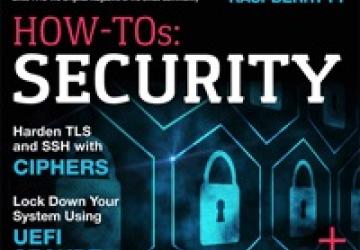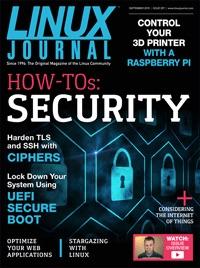September 2015 Issue of Linux Journal: HOW-TOs


How to Do That Thing You Do
I love to learn. I've always been a learner, so grade school and college were both extremely enjoyable for me. That doesn't mean I always got the best grades, because I never really cared about how successful I was; I just cared that I absorbed more knowledge and skills. When I was in college (early 1990s), the Internet came into its own, and my insatiable desire for knowledge found its Holy Grail. This issue of Linux Journal is dedicated to learning how to do things. If you're like me, that's an awesome prospect, so I won't delay with lots of pontificating.
Reuven M. Lerner starts the issue by discussing what it means to be "fast" in the world of Web applications. It seems like a simple topic, but since speed can refer to many things, and those things can be affected by even more things, it can become complicated fairly quickly. Reuven helps you figure out how to go about speeding up your applications by identifying what you actually should be trying to do in the first place.
In Dave Taylor's scripting column, you'll learn how to play with blocks. No, not blocks of data—children's letter blocks. Whether you want to spell out silly messages to your kids or just want to know how many various words you could spell with a limited number of blocks, Dave's column this month aims to please. Kyle Rankin follows Dave with his final article in his four-part series on 3D printing. He's covered a lot during the past few months, and this final article brings it all together with a how-to on using OctoPrint. It's a great Web-based program for controlling your printer, and if you're thinking about delving into the world of 3D printing, you'll want to catch Kyle's latest installment.
It gives me a great amount of joy seeing space exploration once again gaining popularity in our society. I worried the end of the Space Shuttle program would start a dry spell for NASA, and although NASA's budget is continually slashed, it hasn't stopped interest in space. Last month's Perseid meteor shower, the recent flyby of Pluto and even the upcoming movie The Martian inspired me to write about how to use your computer to help enjoy the cosmos. Being Linux users doesn't hinder you from using software to view the stars, and in this month's column, I discuss the various applications available to aid in your nighttime up-looking or your ability to explore space from your monitor. By the time you read this, the software likely will have updated images from Pluto, so be sure to check it out if you're a space nut like me!
Anyone who has ever been frustrated with UEFI Secure Boot will want to read Greig Paul and James Irvine's article on how to bend UEFI to your will. If you take control of its security features, you can protect your entire system by encrypting the entire disk. I love turning problems into opportunities, and this month, Greig and James provide a perfect opportunity to do just that.
Charles Fisher finishes out this how-to issue with a very important look at hardening TLS and SSH encryption. Thanks to recent exploits, it's painfully obvious that the old reliable SSL encryption is no longer secure. At all. Even SSLv3 has been proven insecure, and so you need to know what to do to keep your data safe. Charles covers the nitty-gritty information on not only what versions of TLS encryption you should be using, but what ciphers are currently reliable. If you're interested in encryption, or are responsible for securing data on your network, be sure to read his article, as it gives a helpful, if sobering, look at the current state of encryption software.
This issue, like every issue of Linux Journal, has many other articles, tips, reviews and community announcements. If you're a lifelong learner like me (and if you're reading Linux Journal, the chances are fairly good you are), you'll find this issue particularly enjoyable. At the very least, hopefully my article will give you a reason to go outside and look to the stars. Looking into the heavens always reminds me just how much there is to learn and discover.
Available to Subscribers: September 1










